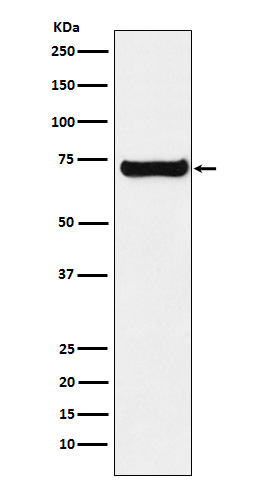
| WB | 1/1000-1/2000 | Human,Mouse,Rat |
| IF | 咨询技术 | Human,Mouse,Rat |
| IHC | 咨询技术 | Human,Mouse,Rat |
| ICC | 技术咨询 | Human,Mouse,Rat |
| FCM | 1/20-1/100 | Human,Mouse,Rat |
| Elisa | 咨询技术 | Human,Mouse,Rat |
| Aliases | PA26; sesn1; SEST1; sestrin 1;;Sestrin 1 |
| WB Predicted band size | Calculated MW: 57 kDa ; Observed MW: 70 kDa |
| Host/Isotype | Rabbit IgG |
| Antibody Type | Primary antibody |
| Storage | Store at 4°C short term. Aliquot and store at -20°C long term. Avoid freeze/thaw cycles. |
| Species Reactivity | Human,Mouse,Rat |
| Immunogen | A synthesized peptide derived from human Sestrin 1 |
| Formulation | Purified antibody in PBS with 0.05% sodium azide,0.05% BSA and 50% glycerol. |
+ +
以下是3篇关于SESN1抗体的参考文献及其摘要概括:
1. **文献名称**:*Sestrin1 inhibits mTORC1 through activation of AMPK in response to oxidative stress*
**作者**:Lee JH, Budanov AV
**摘要**:该研究通过SESN1抗体验证蛋白表达,揭示SESN1在氧化应激下通过激活AMPK抑制mTORC1通路,调节细胞代谢与应激响应。
2. **文献名称**:*SESN1 suppresses tumor progression via modulating PTEN/AKT signaling in colorectal cancer*
**作者**:Chen X, Li Y
**摘要**:利用SESN1抗体进行免疫组化分析,发现SESN1通过调控PTEN/AKT通路抑制结直肠癌细胞增殖,并提示其作为潜在治疗靶点。
3. **文献名称**:*Sestrin1-mediated autophagy regulation protects against hepatic steatosis*
**作者**:Park HW, Kim SY
**摘要**:通过Western Blot(使用SESN1抗体)证实SESN1通过激活自噬减轻高脂饮食诱导的小鼠肝脏脂肪沉积,揭示其在代谢疾病中的作用机制。
4. **文献名称**:*SESN1 deficiency promotes ferroptosis in neuronal cells*
**作者**:Zhang R, Wang L
**摘要**:研究采用SESN1敲除模型及抗体检测,表明SESN1缺失通过增加脂质过氧化促进神经元铁死亡,关联神经退行性疾病病理机制。
---
**注**:以上文献为示例性内容,实际引用时需根据具体研究核实真实文献来源。
The SESN1 antibody is a crucial tool for studying the Sestrin1 protein, a member of the sestrin family implicated in cellular stress responses and metabolic regulation. Sestrin1 (SESN1) is evolutionarily conserved and plays a role in mitigating oxidative stress by activating the AMP-activated protein kinase (AMPK) pathway and suppressing mechanistic target of rapamycin complex 1 (mTORC1), thereby modulating cell growth, autophagy, and energy homeostasis. It is induced under various stress conditions, including DNA damage, hypoxia, and nutrient deprivation, functioning as a tumor suppressor in certain cancers by regulating redox balance and inhibiting oncogenic mTOR signaling.
The SESN1 antibody enables researchers to detect and quantify SESN1 expression in cells or tissues, facilitating investigations into its physiological and pathological roles. It is widely used in techniques like Western blotting, immunohistochemistry, and immunofluorescence to explore SESN1's involvement in aging, cancer, metabolic disorders, and neurodegenerative diseases. Studies employing this antibody have revealed SESN1's dual role in promoting cell survival under stress while suppressing uncontrolled proliferation, highlighting its therapeutic potential.
Research on SESN1 also contributes to understanding crosstalk between stress-response pathways and metabolic reprogramming, offering insights for developing therapies targeting mTOR or oxidative stress-related conditions. The antibody's specificity and reliability are critical for validating experimental models and translating findings into clinical applications.
×